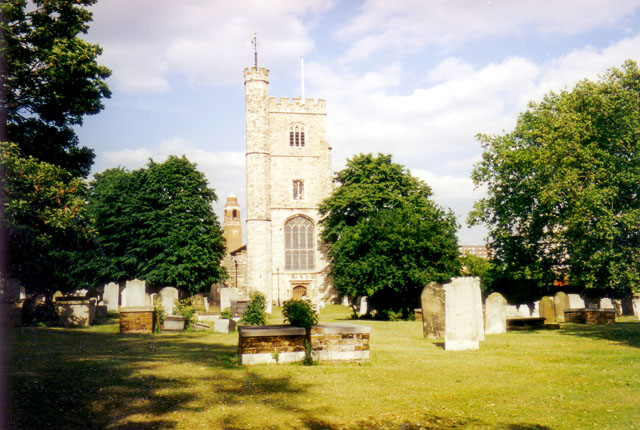St Margaret's Churchyard, Barking (Barking & Dagenham)
Brief Description
St Margaret's Church was founded in 1215 within the precincts of Barking Abbey; it may have been a chapel prior to becoming the parish church in c1300. The churchyard has remains of ancient stone wall abutting the Abbey ruins, and its main entrance is through the C14th Curfew Tower. There are numerous interesting tombs, headstones and monuments as well as fine plane and lime trees.
Practical Information
- Previous / Other name:
- Barking Parish Church
- Site location:
- The Broadway, Barking, Essex
- Postcode:
- IG11
- What 3 Words:
- hips.start.worked
- Type of site:
- Churchyard
- Borough:
- Barking & Dagenham
- Open to public?
- Yes
- Opening times:
- churchyard unrestricted? Church open daily 8am-5pm
- Special conditions:
- Facilities:
- Community Centre, with cafe
- Events:
- Public transport:
- London Overground/Rail/Tube (Hammersmith & City, District): Barking. Bus: 5, 62, 87, 169, 179, 238, 287, 366, 368, 369, 387
- Research updated:
- 01/06/2008
- Last minor changes:
- 19/07/2023
Please check with the site owner or manager for latest news. www.barking-dagenham.gov.uk
Full Site Description
Adjacent to Barking Abbey Ruins (q.v.), the flint and ragstone church of St Margaret was founded in 1215 and has a C13th chancel and octagonal pillars in the north aisle. The arcades were lengthened and the tower added when the church was enlarged in the C15th. Stones from the adjacent Barking Abbey may have been re-used for repairs post 1540. Within the church are numerous monuments and memorials dating back to the days of the Abbey; Captain James Cook was married to Elizabeth Batts here in 1762. The churchyard has a wide range of interesting tombs, headstones and monuments as well as some fine plane and lime trees and is enclosed by ancient stone walls adjacent to Barking Abbey/Abbey Grounds, with early C20th railings on The Broadway boundary and a brick wall on Abbey Road boundary. The main entrance to the churchyard is via Curfew Tower, the C14th Gateway to Barking Abbey; in a room over which is an early C13th rood with figures of Christ, the Virgin and St John.
Outside the churchyard, in front of Curfew Tower stands The Three Lamps - a lamppost moved here in the 1970s from its original site outside Captain Cook pub. It was a prominent meeting place in the Broadway since Victorian times and has associations with the Salvation Army, suffragette movement and trade union movement.
Sources consulted:
Barking Official Guide (1931); Ben Weinreb & Christopher Hibbert, 'The London Encyclopaedia' (Macmillan, revised ed. 1993), pp 752-3; Victoria County History; Arthur Mee 'The King's England: London North of the Thames except the City and Westminster', (Hodder & Stoughton, 1972); Sue Curtis, 'Barking, A History', (Phillimore, 2006)
Further Information (Planning and Conservation)
- Grid ref:
- TQ441839 (544043,183901)
- Size in hectares:
- 1.12
- Site ownership:
- Chelmsford Diocese
- Site management:
- LB Barking & Dagenham, Parks and Countryside Ranger Services
- Date(s):
- C13th
- Designer(s):
- Listed structures:
- None
- On National Heritage List for England (NHLE), Parks & Gardens:
No- Registered common or village green on Commons Registration Act 1965:
No- Protected under London Squares Preservation Act 1931:
No
Local Authority Data
The information below is taken from the relevant Local Authority's planning legislation, which was correct at the time of research but may have been amended in the interim. Please check with the Local Authority for latest planning information.
- On Local List:
- No
- In Conservation Area:
- Yes
- Conservation Area name:
- Abbey and Barking Town Centre
- Tree Preservation Order:
- No
- Nature Conservation Area:
- Yes - Local Importance
- Green Belt:
- No
- Metropolitan Open Land:
- Yes
- Special Policy Area:
- No
- Other LA designation:
- None
Photos
St Margaret's Churchyard, May 1999. Photo: S Williams
Click a photo to enlarge.
Please note the Inventory and its content are provided for your general information only and are subject to change. It is your responsibility to check the accuracy.








